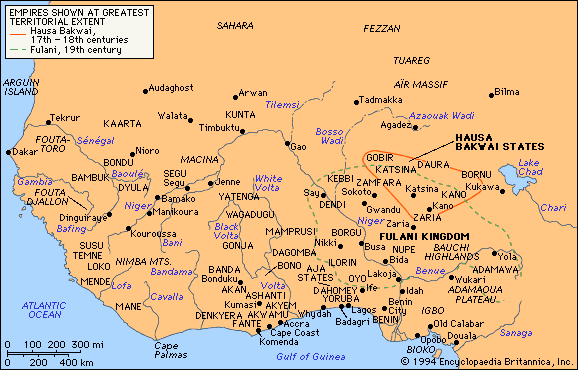
HISTORY OF AFRICAN VISUAL ART
(adapted from Encyclopedia Britanica)
African art usually refers to the works of black, or sub-Saharan, Africa, that part of the continent originally inhabited by Negro peoples who developed cultures quite distinct from those of Caucasian North Africa. Within this huge geographic area are regions of radically different topography, climate, and natural resources. The economies of these regions, therefore, also differ radically from one another, as do the customs, religions, languages, and artistic expressions of their peoples. There is startling diversity within each of the regions as well. It is common to divide sub-Saharan Africa into the following geographic regions: the open grasslands of the Sudan stretching across the continent just south of the Sahara, the woodlands and forests of West Africa, the basin of the Congo River in Central Africa, the East African savannas, and the savannas and deserts of southern Africa. None of these regions has a uniform culture.
Knowledge of the history of visual arts in Africa is very fragmentary. The earliest-known sculptures are the pottery heads and figures of the Nok culture of Nigeria (500 BC to AD 200). This also provides the earliest evidence for ironworking in sub-Saharan Africa, where the Iron Age directly follows the Stone Ages. The earliest evidence for the use of copper and its alloys comes from the Igbo village of Igbo-Ukwu, also in Nigeria, where sites of the 9th century AD have revealed cast bronze regalia among other works of art. These bear no relationship in style either to the famous brass castings of the Yoruba city of Ife (11th-15th century) or to those of Benin (15th-19th century), both in Nigeria. Other examples of antique pottery sculpture include the heads from Lydenburg in South Africa dated to about AD 500. Sculptures in stone are known from Sierra Leone, probably the work of Sherbro carvers and datable to no later than the 16th century, and from the Kongo peoples of the area near the mouth of the Congo river. In the 16th century, ivory was being carved with extraordinary skill at Benin and by the Sherbro of Sierra Leone. The earliest-known sculptures in wood may be certain portrait statues of kings of the Kuba, central Zaire, thought to date from the 17th century. Some of the finest sculptures in wood date, however, only from the 1920s: for example, the works of Yoruba masters such as Olowe of Ise (d. 1939) and Areogun of Osi-Ilorin (c. 1880-1954). The earliest-known textiles in sub-Saharan Africa are the bast fibre fragments from Igbo-Ukwu (9th century AD) and the cotton and woolen cloths found in the Tellem caves of the Bandiagara region of Mali (11th century and earlier). None of these artistic manifestations represents a beginning of any kind: each appears as fully developed in style.
Principal kingdoms and peoples of western Africa, 17th-19th century

Learn more about African people
Learn more about African geography